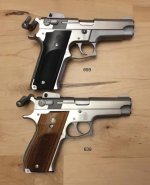FWIW, when the factory stopped teaching armorers to 'eyeball' the proper decocking timing, they gave armorers the numbers of 3 metal drill bits, using the non-cutting end of the bits as 'gauges' to check for Go & No-Go tolerances. The numbered metal bits were 0.078", 0.045" and 0.025". A friend of mine (senior armorer at that time) made me some pins of the proper sizes and installed them in short aluminum stock handles. I inherited his set when he passed, later.

This reminded me of an earlier time with an armorer instructor showed us how to use a couple of the original S&W cup-end pin punches to get in the right ballpark when fitting a new sear release lever on 69XX guns. It was shown because the old 'eyeball' way of checking fit/function involved pulling back on the already decocked spurred hammers and letting them snap forward (once or twice).
If the lever was within proper spec, letting the decocked hammer snap forward would make the already partly lowered safety/decock lever drop the rest of the way down. If it didn't make it finish lowering, then the sear release lever had to be removed and filed a bit more, and the test repeated (until it did).
It was naturally difficult to grasp the decocked spurless hammers to perform that test, although the oldest of the 69XX guns had flash chromed hammers with serrations on the top of the spurs, and those serrations could be grabbed with the edge of the supplied maple wedge so they could be pulled back the rest of the way to let drop. It was easier just to use the right sized pin gauges, positioned underneath the bottom rear corner of the L/S decocking lever, within the machined recess in the slide. (See the excellent pics in the first link in my previous post.)
Hence, using the properly sized pins/drill bits as gauges was an easier thing to teach armorers.
Bottom line, getting the
decocking timing within the proper spec is critical for safety. Especially in the 1st gen guns, since they didn't have firing pin safety plungers. The release of the hammer needs to happen in the right 'timing' during decocking, so not only inner machined shoulders of the manual safety/decocking body can grab the corresponding shoulders of the firing pin, but the rear of the firing pin is also covered (and protected from impact) by the steel safety body as the assembly rotates.


